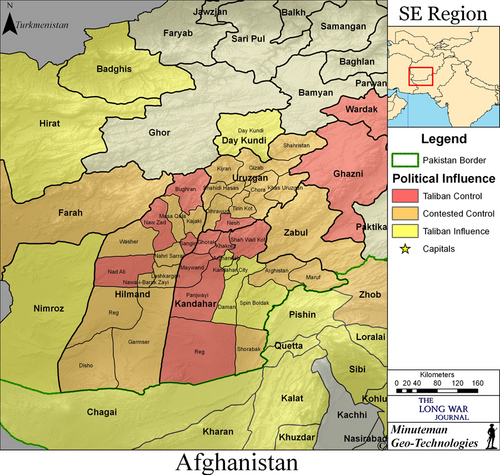DVIDS just posted an interesting story on a complex Taliban ambush against a US Army fuel convoy moving through the mountains at the border of Kandahar and Uruzgan provinces. A battalion of Taliban fighters established a “two-mile kill zone” in the mountains and attacked a 22-truck convoy from the 286th Combat Support Sustainment Battalion.
The Taliban used IEDs, mortars, RPGs, heavy machine guns, and other weapons during the ambush. The Taliban didn’t break contact with the convoy despite being on the receiving end of US air support from helicopter gunships and attack aircraft. The Taliban even attempted to flank the convoy as it regrouped outside of the kill zone, and they inflicted heavy damage on the vehicles in the convoy during the battle. From DVIDS:
At the end of the two-mile kill zone, the convoy had established a green zone, an area to regroup. When the enemy started to flank the green zone, an F-18 Hornet dropped two 500 pound bombs on the mountainside….
During the nine-hour battle, insurgents fired approximately 14 RPGs along with detonating multiple roadside bombs and pummeling the convoy with small-arms fire. Some insurgents used armor-piercing rounds. Militants fired machine guns and assault rifles from nearby homes, the tree line or from dug-in positions on the mountain ridges. Although the militants were well-covered, many Soldiers recalled the enemy had been close enough to see faces.
After the battle, several Soldiers reported seeing doors in the hillside and speculated hollowed areas in the ground may have held weapon and ammunition caches.
Five Soldiers were evacuated that day, and one Soldier evacuated the following day to receive medical attention. So far, three of them have received the Purple Heart Medal.
Five MRAPs were disabled, and ten PLS trucks had been hit by mortar rounds. One RPG hit a PLS, and two RPGs hit at the rear of Gun Truck Four, taking out its rear tires with shrapnel. Fortunately for the convoy, several IEDs never detonated.
The US troops are fortunate to have suffered only five wounded. This is a testament to their training and leadership.
I’ve read several accounts such as this from US Marines serving in Helmand and Farah provinces (usually brief descriptions in PowerPoint presentations outlining Taliban tactics). The Taliban, despite their shortcomings in command and control, are still able to carry out effective company and battalion-sized operations in southern Afghanistan and control territory. The regions between Kandahar and Uruzgan are essentially Taliban-controlled or contested areas (see map below, last updated in May, but still largely accurate, although some areas can be upgraded or downgraded a shade). These are areas with little or no ISAF & Afghan presence; areas where the Taliban have operated for years without any significant opposition save the occasional airstrike or raid.
While the Marines have had success in tamping down the Taliban in southern Helmand, there are still large swaths of southern Afghanistan outside the control of the Afghan government and NATO forces. The 286th Combat Support Sustainment Battalion passed through one such area on July 29 and was fortunate to come out alive. Before anyone can even consider wooing any lower level Taliban leaders and fighters away from the insurgency, the Taliban in these areas will need to be confronted and the ground will need to be controlled. Because until then, the Taliban in these areas have the upper hand and will have no reason to abandon the fight that they are currently winning.
|
Click map for full view. Taliban presence, by district, in Kandahar, Uruzgan, and Helmand provinces. Information on Taliban presence obtained from open source and derived by The Long War Journal based on the presence of Taliban shadow governments, levels of fighting, and statements from ISAF commanders. Map created by Bill Raymond for The Long War Journal. Last updated May 26, 2009. |
Are you a dedicated reader of FDD's Long War Journal? Has our research benefitted you or your team over the years? Support our independent reporting and analysis today by considering a one-time or monthly donation. Thanks for reading! You can make a tax-deductible donation here.








